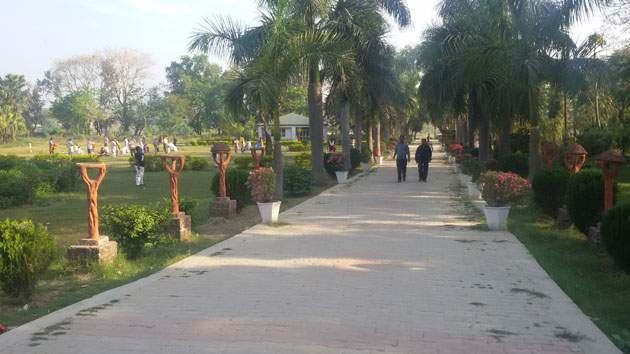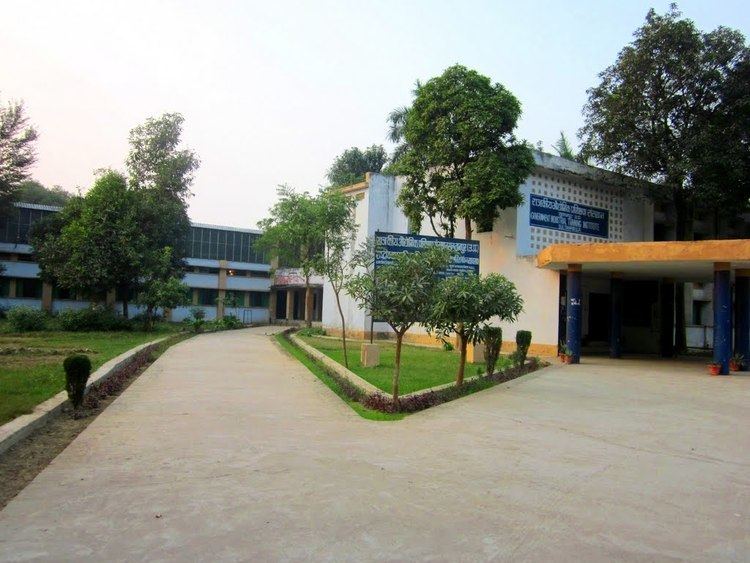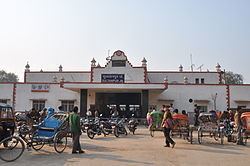Country Language spoken Hindi District | ||
Map of Sultanpur, Uttar Pradesh
Sultanpur is a city and a municipal board in Sultanpur District in the Indian state of Uttar Pradesh. Located on the right banks of the Gomti river (a major tributary of the Himalayan Ganga River), Sultanpur is the administrative headquarters of Sultanpur District and is a part of Faizabad Division. According to the 2011 Indian census, Sultanpur has a population of 116,211 people. Total area occupied by Sultanpur is 4436 km2. The common language of the people of Sultanpur is Awadhi, dialect of Hindi.
Contents
- Map of Sultanpur Uttar Pradesh
- Sultanpur city in upindia
- Historical background Sultanpur
- Sultanpur
- Festivals
- Mentions in literature
- Geography and climate
- Demographics
- Communication and radio stations
- Notable people
- References

Sultanpur is distinguished for its unique culture. Sultanpur (सुलतानपुर), another name of Kushbhawanpur ( कुशभवनपुर) the name is however often confused for "सुल्तानपुर - City of Sultan . Although the area has been part of successive North Indian kingdoms through centuries, the recorded history of the city began in the colonial times. Long a center of Hindu and Buddhist culture it fell under Muslim occupation in the 12th century. The town was completely destroyed during the military operations of the Revolt of 1857.

Places of interest in Sultanpur are Victoria Manzil, Christ Church and Chimanlal Park. The city has a large number of temples and palaces.

Sultanpur city in upindia
Historical background Sultanpur

The Sultanpur district Gazetteer published in 1903 A.D. sheds some light on the history and origin of the district. It notes that the chief land owning families of the time were the Rajputs of various clans, who possessed 76.16% of the total land area mainly resided in place today known as narayanpur. Among them Raghuvanshies and the Rajkunwars popularly known as Rajkumar thakurs along-held over one-fourth of the district, while their kinsmen, the Bachgotis and Rajwars owned 11.4 and 3.4%, respectively. They had their haveli in narayanpur has been parted now by their ancestors. The Rajkunwars traced there ancestry to Hammir Dev Chauhan of Ranthambore.The Rajkunwars were the only ruling clans of Sultanpur to unite all the other clans of the area under one flag and form a grand State around the 16th century under Maharaj Bariarshah Rajkunwar of Bhaddaiyan Raj but the state and power of Rajkunwars was dissolved after the great uprising of 1857 as they supported the natives.The victorious British forces demoted the state to a zamindari and the Raja of dera was given the title of the heads of Rajkunwar. The head of rajkumar and raghuvanshi's thakur was raja ARJUN SINGH. The head of Bachgotis was the Raja of Kurwar while the taluqdar of Samrathpur represented another branch of the family. The chief of Rajwars was the taluqdar of Pratabpur. Another member of the Rajwars family was the Raja of Hasanpur. Laterly raja hasanpur family, and royal family of Narayanpur parted themselves and the royal faimly of narayanpur lived in narayanpur but as "daan" many of their land and resources they gave to hasanpur. Allied to him were the families of Maniarpur and Gangeo and between them they owned a large portion of the central area. Next to Bachgotis and their kinsmen come the Bandhalgotis, who owned almost the whole of Amethi pargana. Their head was the Raja of Amethi, while the taluqdar Shahgarh belonged to the same clan. Till now royal family of narayanpur started to giving "dan" to needy and poor people and their vast empire was degrading day by day. Raja Arjun singh told his son Bhagwandas to always support his praja. These were the last words of king. After them the Rajputs with large properties in the district were the Bhale Sultans who owned 4.72%, the Kanhapurias with 4.7%, and the Bais with 2.8%. Bhale Sultans were dwelling in the north west corner of the district in the parganas of Isauli, Musafirkhana and Jagdishpur. The Kanhpurias were chiefly confined to pargana Gaura Jamo, almost the whole of which belonged to them. The Bais were scattered about in small groups.
Most of the land was now given by narayanpur family but still the main part of sultanpur was under them. Raja Bhgwandas was succeeded by Raja Rajnarayan from whose name Narayanpur got its name. Raja Rajnarayan was ill in his last days. He left world and a huge empire to a widow queen and told her to be always kind to his praja at any cost. The queen was very famous in Narayanpur, Sultanpur as well as nearby areas specially in poor people and got her name "Pee Mai". She took the empire with honour and nourished it. Her landmark are still in first haveli of Narayanpur which is by now divided. Later the zamindari system got banished and she was left with four sons and a huge empire to feed. It was these four sons among whom this haveli of narayanpur was divided and later everyone moulded it into his home.
Some remarkable work done by Rajnarayan was establishment of judicial system of Sultanpur district whose notations can be seen in Sultanpur District court.
Elder son of Rajnarayan was Thakur Awadhendra Pratap Singh. Who was the last ancestor known of this huge kingdom. Later he married with Shanti Devi and had 8 children. Among whom Dheerendra Pratap Singh, Vinay Singh and Sarwan Singh are among notable persons in Sultanpur. Sarwan singh is also a social activist and politician in Sultanpur
Sultanpur
Another important branch of the land owning clans was the house of Raj Sah. Raj Sah had three sons, Ishri Singh, Chakrasen Singh and Rup Chand. From Ishari Singh, after nine generations came Bijai Chand, who had three sons. Harkaran Deo. Jit Rai, and Jionarain. Harkaran Deo was the ancestor of Nanemau taluqdar; the ancestors of Nanemau taluqdar were known as kot darbar Near to the bank of Gomati river of Nanemau. The descendants of Harkaran Deo were Shivadutta and Gajadhar. Mahaved and Bhagwati were the last rular of the Nanemau estate. Jit Rai were the owners of Meopur Dahla, Meopur Dhaurua, and Bhadaiyan; and from Jionarain descended the Raja of Dera. The fourth descendant of Jionarain led the first of the six colonies of Rajkumars across the Gomti and planted himself at Dera on the banks of the river. This house became one of the main branches of the Bachgotis of Sultanpur.
At the beginning of the nineteenth century Babu Madho Singh, eleventh in descent from Jionarain was the rular of the estate which consisted of 101 villages. Babu Madho Singh who is remembered as the successful leader and who managed his property well died in 1823. He was succeeded by his widow, Thakurain Dariao Kunwar, a most remarkable woman, who through toil and turmoil not only bravely held her own, but added to her estates than her husband had done in his lifetime. The direct line of succession had ended with the death of Thakurain's husband, Babu Madho singh. The Next male collateral heir was Babu Rustam Sah, whom Thakurain disliked. Babu Rustam Sah was in the service of Maharaja Man Singh, the nazim of the day and with his help succeeded in capturing Thakurain and made her write a deed in his favour. That formidable woman, whose pride was hurt, grieved for a few months and died. Rustam Sah was given the possession of the property by the nazim. Rustam Sah came to know later that the nazim had ulterior motives in helping him. A fight would have followed and Rustam would have killed nazim, but for a pandit who advised him that the time was not propitious. Later, Rustam Sah sought asylum across the British border and was made the taluqdar of Dera, which consisted of 336 villages. Rustam Sah rendered excellent service during the Mutiny. He died in 1877 and was succeeded by his nephew, Raja Rudra Pratap Singh.
.
Festivals
Goddess Durga is believed to arrive for her annual stay on earth at the beginning of Navaratra and leaves on Vijayadashmi. But in Sultanpur district, Durga enjoys an extended stay. It's the most well recognised festival of Sultanpur.About 130 kilometers from the state capital, this town turns into a 'mini Kolkata' during this period with hundreds of durga idols in a vast temple complex. Chowk area, the heart of Sultanpur, begins to resemble Bhowanipore or Kalighat of Kolkata. Durga puja celebrations in typical Bengali style began in Sultanpur in 1959. Since then, Durga has been installed in pandals with praan prathishtha on Saptami (seventh) day of Navaratra. The deity stays in the city till Sharad Purnima, a week after Durga Visarjan on Vijaydashmi in other places. Durga's extended stay is a matter of pride for us," says Om Prakash, president, central puja committee Sultanpur, adding, "Our elders quoted from Durga Shaptashati and told us the idol may be installed for two, nine or 14 days and we decided to keep it for the longest time." On what made Sultanpur, a part of the kingdom of Lord Rama's son Kush, celebrate divinity's homecoming, historian B C Mishra has an answer. "The tradition may be only 57-years old but there is mythological evidence that this is the place Goddess Durga in one of her avatars killed Madhukaitav and other demons here," he says. Also, the banks of Gomti river, where the city is situated, was where saints like rishis Agastya, Uhawal, Parashar, Bhagirath and Durvasa offered penance. And they all remembered Shakti in some form, he added. The tradition of pandals was started by Bhikhari Lal Soni and his friend Narsingh when this native from Bihar decided to 'invite' divinity to his 'karmabhoomi' (place of work). Even today, the pandal set up by his committee is most important while the goddess is known as 'Badi Durga'. The visarjan too is a treat of sorts for the eyes. All the idols in the city are arranged for the farewell. Hundreds of Durgas together is a rare sight this side of Kolkata. Bhandaras and bhogs are another festive part of the season.Idols are made by different kind of things like cashewnuts, nuts, almonds, shankhs, pearls etc.
Mentions in literature
The original town was situated on the left bank of the Gomti. It is said to have been founded by Kusa, son of Rama, and to have been named after him Kusapura or Kusabhavanpur. This ancient city has been identified by General Cunnigham as Sultanpur mentioned by Hiuentsang, the Chinese traveller. He states that there was in his time a dilapidated stupa of Ashoka and that Buddha taught here for six months. There are Buddhist remains still visible at Mahmoodpur, a village, 8 km distant to the north-west of Sultanpur. The town subsequently fell into the hands of Bhars, who retained it until it was taken from them by Muslims in the 12th century. About seven hundred and fifty years ago, it is said, two brothers, Sayid Muhammad and Sayid Ala-ud-Din, horse dealer by profession, visited eastern Avadh and offered some horses for sale to Bhar Chieftains of Kusabhavanpur, who seized the horses and put the two brothers to death. This came to the ear of Ala-ud-Din Khilji, who would not allow such an outrage to pass unpunished. Gathering a mighty force, therefore, he set out for Kusabhavanpur and took revenge by killing most of the Bhars by strategem adopted after a long drawn siege. Kusabhavanpur was reduced to ashes and the town of Sultanpur, so called from the rank of the victor, rose upon its ruins. This town was finally raised to the ground during the military operations connected with the reoccupation of the province in consequence of the inhabitants having been concerned in the murder of British officers at the outbreak of the freedom struggle of 1857. Before annexation a military station and cantonment were established on the right bank of the river in a village then known as Girghit but more commonly called by officials Sultanpur or Chhaoni Sarkar and by the rustic population Kampu or the Cam. The present town of Sultanpur has been developed at this site. In this city there are two parks, one maintained by Soldiers', Sailers' and Airmen's board and other privately maintained known as Chimanlal Park. Alibrary called Vinayak Mehta Library Trust Association and contains over 10,000 books.
Geography and climate
Sultanpur is the headquarters of the Sultanpur district, north side of this district is bounded by Faizabad district, south side is bounded by Pratapgarh district, west side is bounded by Barabanki district and Raebareli district and the east side is bounded by Azamgarh district, Ambedkarnagar district, and Jaunpur district. It has an average elevation of 95 metres (312 ft). Geography of Sultanpur comprises plain lands except some regions around gomti river which drains almost the whole city and district, however southern part of city drains towards Sai river flowing through the Pratapgarh district. The only significant mineral found in region is Kanker. Moreover, Clay is also found in almost all parts of the region.
Sultanpur has a tropical wet and dry climate with average temperatures ranging between 20 to 28 °C (68 to 82 °F). Sultanpur experiences three distinct seasons: summer, monsoon and a mild autumn. Typical summer months are from March to May, with maximum temperatures ranging from 30 to 38 °C (86 to 100 °F). The warmest month in Sultanpur is April; although summer doesn't end until May, the city often receives heavy thundershowers in May (and humidity remains high). Even during the hottest months, the nights are usually cool due to Sultanpur's altitude. The highest temperature ever recorded was 48.3 °C (118.9 °F). The monsoon lasts from June to October, with moderate rainfall and temperatures ranging from 10 to 28 °C (50 to 82 °F). Most of the 722 mm (28.4 inches) of annual rainfall in the city fall between June and September, and July is the wettest month of the year. Autumn begins in November. The daytime temperature hovers around 28 °C (82 °F) while night temperature is below 10 °C (50 °F) for most of December and January, often dropping to 3 to 4 °C (37 to 39 °F). The lowest temperature ever recorded was 1.7 °C.
Demographics
As per provisional data of 2011 census, Sultanpur urban agglomeration had a population of 116,211 out of which males were 61,062 (52.54%)and females were 55,149 (47.46%).Sultanpur has an average literacy rate of 87.61%, of which male literacy is 91.45%, and female literacy is 83.37%. In Sultanpur, 10.44% of the population is under 6 years of age. Sex ratio is 904 per 1000 males. The child sex ratio stands at 886 girls against 1000 boys.
Communication and radio stations
All prominent telecommunication network provider in India offers their services in Sultanpur. The city of Sultanpur falls under Uttar Pradesh Central telecom Circle. Calls from city of Sultanpur to neighbouring districts including rest of the area in the Uttar Pradesh and Uttarakhand telecom circle are considered to be local.
Radio services
Radio is one of the modes of entertainment in Sultanpur. Radio services available are:
